Bronze Age - Far East - Photo gallery
Image database with photographs of ancient art and antiquities
Our image database provides photographs of ancient art and antiquities for press releases as well as for private use. All artefacts sold in our gallery are documented through professional photographs. The resulting image library contains numerous ancient Egyptian, Greek and Roman antiquities as well as ancient coins. The time span from Stone Age, over Bronze Age and Classical Antiquity until Late Antiquity is covered.The photo gallery aims at providing a vast visual archive equipped with filters and search tools. You are most welcome to search the constantly growing number of artefacts in the image library. We are also happy to authorize hyperlinks from your webpage / forum to the objects depicted in our gallery. For this purpose, please send us a short notification prior to placing a hyperlink. For almost every object high definition photographs are available and can be provided e.g. to document your collection or for scientific papers or popular science articles. If you are interested in using pictures for publications, print media or other purposes, please contact us and we will be happy to assist you.
-
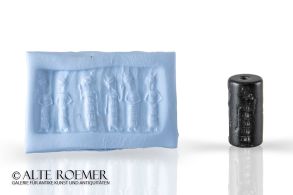 Near Eastern cylinder seal
Near Eastern cylinder sealThe seal of black stone bears a scene with four noblemen or gods. Late Syrian, around 1500 BC.
Price: on request Terra cotta idol from Syria
Terra cotta idol from SyriaCharacteristic figure for the Bronze Age in the region that is today northern Syria. Dating to the 3rd or early 2nd Millennium BC.
Price: on request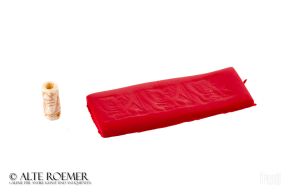 Mesopotamian cylinder seal
Mesopotamian cylinder sealThe marble seal bears a fight scene with lions. From the Early Dynastic or Akkadian period in the later 3rd Millennium BC.
Price: on request Luristan axe head
Luristan axe headBronze axe originating from the Luristan region during Bronze Age. From the Sasson family collection.
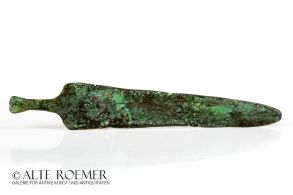 Luristan bronze dagger
Luristan bronze daggerDouble-edged blade of a short dagger from the Luristan region in Ancient Iran. An early type from the Middle Bronze Age.
 Luristan bronze dagger
Luristan bronze daggerDouble-edged blade of a dagger from the Luristan region in Ancient Iran. An early type from the Middle Bronze Age.
 Very large Italic wave-shaped brooch
Very large Italic wave-shaped broochMade from bronze wire. A very rare brooch type from around 1000 BC.
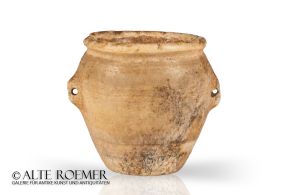 Egyptian stone beaker
Egyptian stone beakerElegant stone vase made of beautifully marbled calcite alabaster. From between the 1st and 3rd dynasty of ancient Egypt.
 Group of Italic brooches and artefacts
Group of Italic brooches and artefactsExciting group of 17 bronze objects. These include an Italian serpentine fibula with large disc head, three early Etruscan brooches, and a bronze sheet with a decorative head.
Price: on request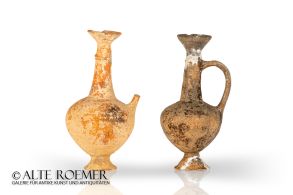 Two cypriot juglets
Two cypriot jugletsSo-called Bilbil jugs of the Base Ring I ware. A testament to the opium trade of the late Bronze Age.
 Egyptian model vessels of a founding ceremony
Egyptian model vessels of a founding ceremonyA group of seven miniature bowls and three miniature vases made of clay. Once filled with offerings and used ritually during a foundation stone laying ceremony. Dating to the Old Kingdom, around 2500 BC.
Price: on request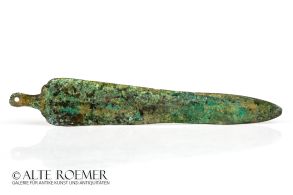 Luristan bronze dagger
Luristan bronze daggerDouble-edged blade of a short dagger from the Luristan region in Ancient Iran. An early type from the Middle Bronze Age.
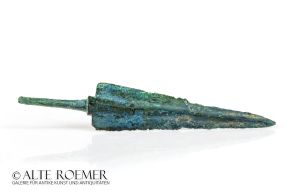 Near Eastern spearhead
Near Eastern spearheadDouble-edged blade of a small spear or large arrow from Bronze or Early Iron Age. With a nice green patina.
 Luristan battle axe with eyes
Luristan battle axe with eyesAxe head originating from the Luristan region during Early Bronze Age. The piece is decorated with eyes to form a stylized bird's head.
 Luristan bronze axe
Luristan bronze axeNicely decorated axe head originating from the Luristan region. From the Sasson family collection.
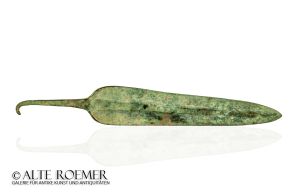 Luristan bronze dagger
Luristan bronze daggerDouble-edged blade of a long dagger from the Luristan region in Ancient Iran. From the Sasson family collection.
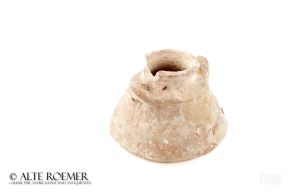 Bronze Age clay vessel
Bronze Age clay vesselNice small biconical vessel from the Eastern Mediterranean. Dating to the Late Bronze Age.
 Clay tablet with cuneiform text
Clay tablet with cuneiform textSmall cuneiform writing tablet with well preserved text on both sides.
Price: on request Neolithic flint dagger from Denmark
Neolithic flint dagger from DenmarkDouble-edged blade and flat shaft made of beautiful flintstone. A status symbol from the transitional period between Late Neolithic and Early Bronze Age.
 Neolithic dagger blade from Denmark
Neolithic dagger blade from DenmarkDouble-edged, pointed blade made of beautiful flint. The blade was for a dagger, the typical status symbol from the transitional period between Late Neolithic and Early Bronze Age.
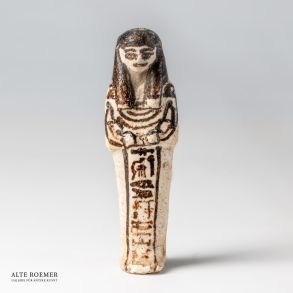 Egyptian ushabti for Viceroy Hori
Egyptian ushabti for Viceroy HoriOne of only 30 known funerary statuettes from the tomb of Hori I, King's son of Kush. Viceroy of Kush in Nubia during the reign of the pharaohs Ramesses III and IV. An exhibited and repeatedly published piece.
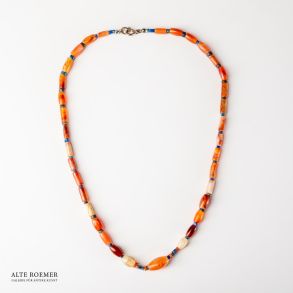 Necklace of Sumerian beads
Necklace of Sumerian beadsBeautiful beads of orange-patterned carnelian, beige-banded agate, and pleasantly contrasting blue lapis lazuli. Similar to the jewelry of the Sumerian queen Puabi. Early Dynastic Period of Mesopotamia, around 2500 BC.
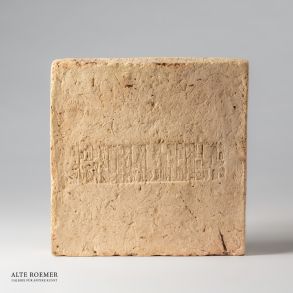 Sumerian brick with royal inscription
Sumerian brick with royal inscriptionClay tile from the temple of Eridu, donated around 2040 BC. Dedicated by Amar-Sin, king of the Third Dynasty of Ur. Studied for a research project in 1983.

